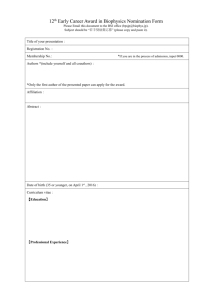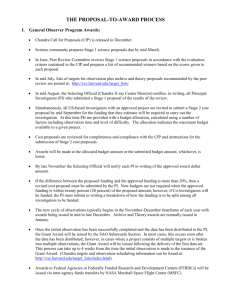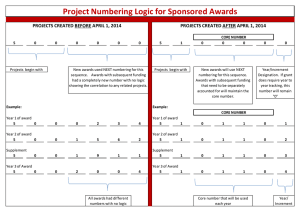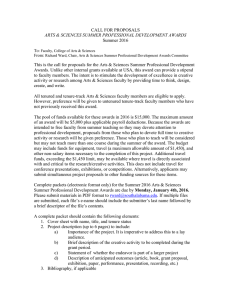Contracts & Grants Q216 Award Report Maintaining the status quo Summary
advertisement
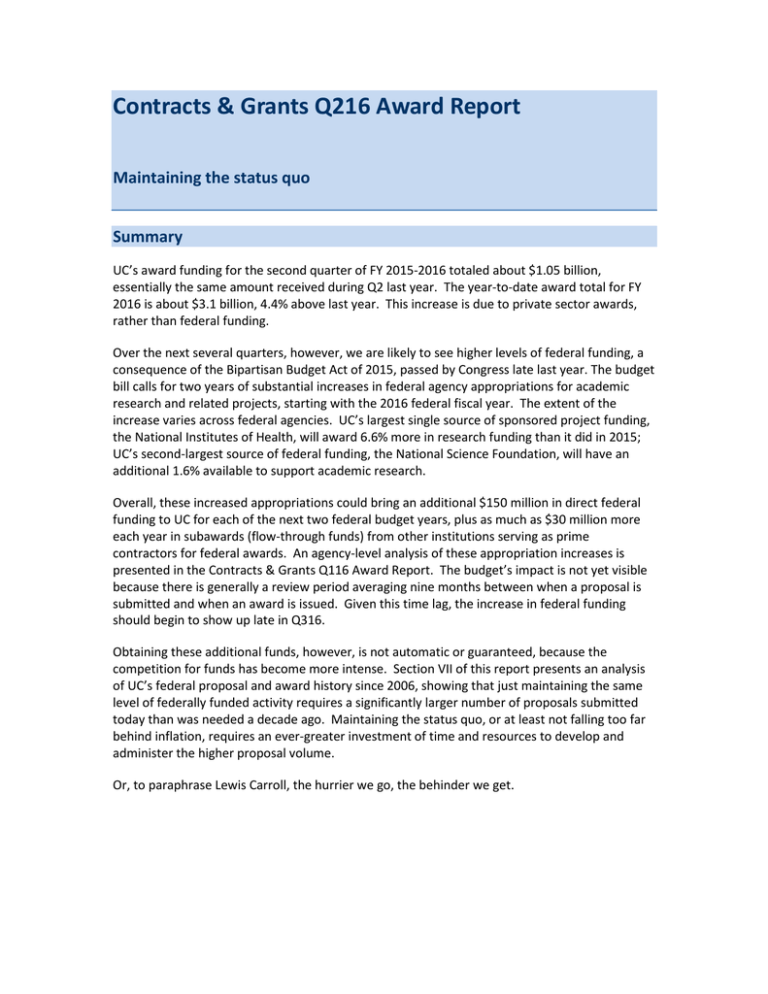
Contracts & Grants Q216 Award Report Maintaining the status quo Summary UC’s award funding for the second quarter of FY 2015-2016 totaled about $1.05 billion, essentially the same amount received during Q2 last year. The year-to-date award total for FY 2016 is about $3.1 billion, 4.4% above last year. This increase is due to private sector awards, rather than federal funding. Over the next several quarters, however, we are likely to see higher levels of federal funding, a consequence of the Bipartisan Budget Act of 2015, passed by Congress late last year. The budget bill calls for two years of substantial increases in federal agency appropriations for academic research and related projects, starting with the 2016 federal fiscal year. The extent of the increase varies across federal agencies. UC’s largest single source of sponsored project funding, the National Institutes of Health, will award 6.6% more in research funding than it did in 2015; UC’s second-largest source of federal funding, the National Science Foundation, will have an additional 1.6% available to support academic research. Overall, these increased appropriations could bring an additional $150 million in direct federal funding to UC for each of the next two federal budget years, plus as much as $30 million more each year in subawards (flow-through funds) from other institutions serving as prime contractors for federal awards. An agency-level analysis of these appropriation increases is presented in the Contracts & Grants Q116 Award Report. The budget’s impact is not yet visible because there is generally a review period averaging nine months between when a proposal is submitted and when an award is issued. Given this time lag, the increase in federal funding should begin to show up late in Q316. Obtaining these additional funds, however, is not automatic or guaranteed, because the competition for funds has become more intense. Section VII of this report presents an analysis of UC’s federal proposal and award history since 2006, showing that just maintaining the same level of federally funded activity requires a significantly larger number of proposals submitted today than was needed a decade ago. Maintaining the status quo, or at least not falling too far behind inflation, requires an ever-greater investment of time and resources to develop and administer the higher proposal volume. Or, to paraphrase Lewis Carroll, the hurrier we go, the behinder we get. 2 Q216 Contracts & Grants Award Report I. Quarterly Performance Metrics Extramural awards for Q216 totaled $1.048 billion, which is only $900K above the Q215 total. Awards for the first quarter of 2015-16, however, were $128 million above Q115, so the year-todate total is 4.4% higher than last year. With federal funding on a plateau until increased agency appropriations begin to show up as awards, these year-to-date differences are due principally to increases in private sector funding. Q1+Q2 Extramural Awards $ millions, inflation-adjusted 4,000 Stimulus funds Federal budget constraints 2013 Federal budget bill 3,000 Inflation Q2 Q1 2,000 1,000 0 Quarterly Extramural Awards $ millions, inflation-adjusted 2001 2002 2003 2004 2005 2006 2007 2008 2009 2010 2011 2012 2013 2014 2015 2016 Q1 1,420 1,351 1,722 1,667 1,824 1,592 1,693 1,759 1,812 2,250 2,173 2,143 1,819 1,796 1,896 2,025 Q2 869 1,026 952 1,014 916 927 943 1,107 1,088 1,174 1,218 1,012 1,056 1,211 1,047 1,048 Q3 888 1,008 860 1,047 1,023 985 971 1,135 1,004 1,214 1,032 1,037 1,078 1,086 1,095 Q4 1,067 1,222 1,337 1,243 1,489 1,492 1,529 1,588 1,518 1,519 1,440 1,445 1,416 1,712 1,693 FY 4,245 4,607 4,871 4,971 5,252 4,996 5,136 5,589 5,422 6,157 5,864 5,637 5,370 5,805 5,731 Award totals for UC’s second fiscal quarter are always well below the first-quarter amounts. This is a function of the federal funding cycle, which awards the largest amounts in the final quarter of the federal fiscal year (corresponding to UC’s Q1). With direct federal sponsorship providing about two-thirds of all UC’s awards, this produces sharp quarterly spikes in funding. 3 Q216 Contracts & Grants Award Report FEDERAL ALL OTHER Federal and All Other Awards, by Quarter $ millions, inflation-adjusted 2,500 2,000 1,500 1,000 500 0 2001 2002 2003 2004 2005 2006 2007 2008 2009 2010 2011 2012 2013 2014 2015 2016 II. Award Trends by Sponsor Category Federal awards for Q2 are slightly below last year, as are awards from non-profit organizations and academia. The major increase for the quarter is in awards from corporate sponsors. Q2 Awards by Sponsor Category, ($ millions, inflation-adjusted) SPONSOR Federal State Other Gov’t* Corporate Non-Profit Academia** TOTAL Q207 487 105 29 89 118 115 943 Q208 524 112 20 165 173 114 1,107 Q209 535 103 27 108 183 132 1,088 Q210 607 106 27 78 207 149 1,174 Q211 588 151 25 102 179 174 1,218 Q212 375 102 60 126 187 162 1,012 Q213 472 106 34 114 169 161 1,056 Q214 569 58 24 228 196 137 1,211 Q215 459 44 26 141 215 163 1,047 Q216 448 72 18 187 176 146 1,048 Fiscal-year-to-date comparisons, however, provide a better sense of funding prospects for the year than just the second quarter, which, as the first quarter of the federal fiscal year, can be skewed by federal budget issues. The table below shows that for the year, federal funding is the same as last year, and that there have been large increases in both corporate and non-profit funding. Q1+Q2 Awards by Sponsor Category SPONSOR Federal State Other Gov’t* Corporate Non-Profit Academia** TOTAL 2007 1,688 233 89 149 264 213 2,636 2008 1,714 235 58 273 356 230 2,866 2009 1,783 235 70 221 346 245 2,900 2010 2,345 257 55 175 331 260 3,424 2011 2,285 238 45 195 327 301 3,391 2012 1,900 296 89 260 309 300 3,155 2013 1,635 283 95 214 357 290 2,875 2014 1,758 257 75 323 322 272 3,007 * Other Gov’t includes Agricultural Market Order Boards. **Academia includes the categories of Higher Education, DOE Labs, Campuses and UCOP. 2015 1,737 213 64 275 379 276 2,943 2016 1,738 229 52 386 415 253 3,072 4 Q216 Contracts & Grants Award Report Q1+Q2 Awards by Sponsor Category, FY 2006-07 to 2015-16 $ millions, inflation-adjusted 2,500 2,000 2007 2008 1,500 2009 2010 2011 1,000 2012 2013 2014 2015 500 2016 0 FEDERAL STATE OTHER GOV'T BUSINESS NON-PROFIT ACADEMIA III. Private Funding Awards from both corporate and non-profit sponsors display much variation, quarter by quarter, but both sponsor categories show long-term funding increases. Corporate and Non-Profit Sponsorship, Q106 to Q216 $ millions, inflation-adjusted Non-Profit Corporate Linear (Non-Profit) Linear (Corporate) 250 200 150 100 50 0 2006 2007 2008 2009 2010 2011 2012 2013 2014 2015 2016 5 Q216 Contracts & Grants Award Report IV. Award Trends by Project Type Research awards during Q216 amounted to $846 million, including $116 million in clinical trial sponsorship. Training, service, and other awards came to about $202 million. Research awards during Q215, by comparison, amounted to $823 million, which included $73 million for clinical trial research. Q2 Award Amounts by Project Type, FY 2006-07 to 2015-16 $ millions, inflation-adjusted PROJECT TYPE Research Clinical Trials Training Service Other TOTAL Q207 653 42 57 112 80 942 Q208 787 76 59 73 113 1,107 Q209 780 59 50 103 96 1,088 Q210 937 43 53 85 56 1,174 Q211 882 46 52 110 128 1,218 Q212 720 58 43 95 95 1,012 Q213 772 64 48 96 75 1,056 Q214 785 182 63 98 83 1,211 Q215 750 73 45 57 121 1,047 Q216 729 116 44 108 50 1,048 V. Significant Awards by Location During Q216, UC received about 6,000 contracts and grants from about 1,550 different sponsors (in addition to nearly 1,100 Material Transfer Agreements). Listed below are the largest or most significant awards reported this quarter by campuses, Agriculture & Natural Resources, and Lawrence Berkeley National Lab. LOCATION SPONSOR CATEGORY SPONSOR Agriculture & Natural Resources State California Department of Food And Agriculture Berkeley Davis Corporate Federal Pfizer, Inc. U.S. Agency for International Development Irvine Lawrence Berkeley Lab Corporate Higher Ed INC Research, LLC Stanford Linear Accelerator National Laboratory Los Angeles Federal National Cancer Institute Merced Office of the President Riverside Non-Profit Non-Profit State William M. Keck Foundation Gordon and Betty Moore Foundation California Energy Commission San Diego Non-Profit Patient-Centered Outcomes Research Institute PROJECT TITLE Demonstrating the Economic and Environmental Benefits of Hot-Water Pest Eradication Hepatoselective Gene Editing: Harnessing the Potential of a Novel ASGPR Ligand AMOUNT 401,836 4,002,644 Afghanistan Agriculture Extension Project A Phase III Clinical Trial of Anti Pd-L1 Antibody in Combination With Bevacizumab Versus Sunitinib in Treating Advanced Renal Cell Carcinoma Hard X-Ray Undulators for the Linear Accelerator Coherent Light Source 11,490,485 AIDS Malignancy Consortium (AMC) High-Performance, Single-Molecule Biosensors Based on Downhill Folding Protein Modules Beginning of on-Site Construction of the Thirty-Meter Telescope on Mauna Kea Chemehuevi Indian Tribe Microgrid Patient-Oriented Scalable National Network For Effectiveness Research (Pscanner) 13,134,497 5,268,204 5,429,743 1,000,000 10,000,000 2,588,906 8,623,014 6 Q216 Contracts & Grants Award Report San Francisco Non-Profit Patient-Centered Outcomes Research Institute Santa Barbara Federal Naval Health Research Center Santa Cruz Federal U.S. Department of Education Enabling a Paradigm Shift: A PreferenceTolerant Clinical Trial of Personalized vs. Annual Screening for Breast Cancer Systems Biology of Coagulation and Trauma-Induced Coagulopathy Gear-Up: Creating Access to College GEAR UP Partnership (Pajaro Valley) 14,076,318 1,471,919 1,232,800 VI. Award Trends by Recipient Location Award totals for the first two quarters of FY 2015-16 were slightly ahead of last year by about 4.4%. This increase was not evenly divided across reporting locations. Among campuses, San Francisco, Riverside and Irvine showed significant increases over last year. Q1+Q2 Award Amounts by Location $ millions, inflation-adjusted UC Location FYTD 2013 FYTD 2014 FYTD 2015 FYTD 2016 Berkeley San Francisco Davis Los Angeles Riverside San Diego Santa Cruz Santa Barbara Irvine Merced UCOP LBNL Ag & Nat Res Total 457 681 405 389 56 469 74 89 146 13 26 62 9 2,875 381 785 365 420 55 552 73 111 157 21 12 66 9 3,007 417 714 406 483 60 457 72 85 152 14 6 68 9 2,943 419 779 414 483 66 474 63 80 194 11 15 62 12 3,072 2016-15 Change 0.5% 9.0% 2.0% -0.2% 10.5% 3.8% -12.6% -5.5% 28.0% -23.8% 159.2% -8.1% 31.0% 4.4% VII. Proposals and the rate of return One of the factors in UC’s success in garnering federal awards is that the research community is highly prolific in generating proposals. The majority of federal awards are competitive, and increasingly so; grant-seekers are well aware that only a fraction of the proposals submitted are ultimately funded. At the National Institutes of Health, for example, the proposal success rate for all institutions is about 21%. To assess UC’s systemwide success rate with federal proposals, across all agencies, we can calculate a yield rate based on the dollar volume of federal awards received, compared to the dollar volume of projects proposed. The yield can be estimated by dividing the federal award amount for any given year by the dollar amount of federal proposals submitted the previous year, reflecting the nine-month lag between proposal submission and the reporting of awards for successful proposals. 7 Q216 Contracts & Grants Award Report Federal Fiscal Year Proposals and Awards $ billions, not inflation-adjusted 16 2013 Budget bill Budget constraints Stimulus funds 14 Proposals 12 Awards 10 Linear (Proposals) 8 6 4 2 0 2006 2007 Federal FY 2008 2009 2010 2011 2012 2013 2014 2015 2006 2007 2008 2009 2010 2011 2012 2013 2014 2015 Awards, $M 2,767 2,736 2,976 3,424 3,650 3,366 2,941 2,935 3,404 3,354 Proposals, $M 9,099 9,575 10,318 14,458 12,395 10,821 11,381 12,680 14,564 14,428 0.31 0.31 0.33 0.25 0.27 0.27 0.26 0.27 0.23 N/A Yield (next year) Over the last ten years, there is a general correspondence between amounts proposed and amounts subsequently received. It’s worth noting that when stimulus funds were available during 2009 and 2010, UC’s research community responded with a dramatic increase in the number and dollar amount of proposals, resulting in over $1 billion in stimulus fund awards. Significantly, this history shows how the yield rate per project dollar proposed has been steadily declining. In 2006, UC submitted $9.1 billion in federal proposals and the 2007 federal award total was $2.7 billion, for a yield of about $0.31 on the dollar. By 2014, that yield had dropped to $0.23 per dollar, a clear demonstration of how competitive the federal grant process has become over the last decade. In the face of this long-term, declining yield rate on federal proposals, UC’s research community has adjusted by producing a larger number of proposals. The 2015 proposal count was 28% greater than in 2006. Federal FY 2006 2007 2008 2009 2010 2011 2012 2013 2014 2015 Proposals, $M 9,099 9,575 10,318 14,458 12,395 10,821 11,381 12,680 14,564 14,428 # of Proposals 10,653 11,347 11,546 15,746 12,520 11,501 11,420 12,612 13,310 13,597 Proposal Avg. $K 854 844 894 918 990 941 997 1,005 1,094 1,061 Inflated Prop.Avg. 1,042 992 1,017 1,008 1,094 1,023 1,052 1,037 1,113 1,061 Inflated Award $K 3,376 3,215 3,388 3,760 4,033 3,661 3,105 3,028 3,462 3,354 8 Q216 Contracts & Grants Award Report The average proposal amount has also increased over the last decade, from about $854K to $1.06 million. However, once inflation is taken into account, it becomes clear that the average dollar amount per proposal has not changed over the last decade. What we see here are two critical factors at work: the battle against inflation, and the heightened intensity of competition for grants, as reflected in the lower yield rate. The net effect of this combination of factors is that despite a larger number and dollar volume of proposals, the inflation-adjusted federal award total in 2015 was slightly lower than it was in 2006. These comparisons point to an increasingly demanding and labor-intensive process for obtaining federal contracts and grants. Simply maintaining the same level of federal research activity from year to year has required a substantial increase in the number of proposals submitted. This, in turn, has necessitated an ever-increasing level of effort in drafting, reviewing, processing, submitting and tracking an ever-larger number of proposals. The growing administrative effort required to secure federal grants is one of the less-visible indirect costs of conducting research—costs that are never fully recovered from UC’s federal agency sponsors. Charles Drucker Institutional Research April, 2016
